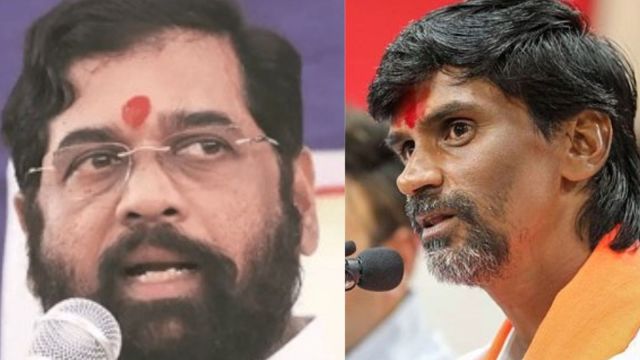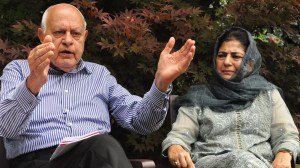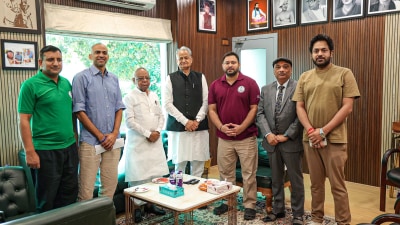Caste to corruption: Five factors that will be at play in Maharashtra polls
Bitterness between Marathas and OBCs, Mahayuti govt's freebies and sympathy wave for Uddhav and Sharad Pawar are likely to play key roles in turning the tide
 Maharashtra Chief Minister Eknath Shinde and Activist Manoj Jarange-Patil. (File Photo)
Maharashtra Chief Minister Eknath Shinde and Activist Manoj Jarange-Patil. (File Photo)Immediately after the announcement of poll dates by the Election Commission of India, Bharatiya Janata Party (BJP) leader and Maharashtra Deputy Chief Minister Devendra Fadnavis announced “Shankhnaad (blowing conch)” through a social media post on “X”, marking the beginning of the electoral battle in the state.
His political opponent from Nationalist Congress Party (SP) and its state unit chief Jayant Patil also declared blowing of “Tutari” (identifying with party poll symbol of Man blowing Turha) on “X”. The single phase poll is scheduled on November 20.
As the two major coalitions — the Mahayuti and the MVA — with three key parties on each side, a bunch of smaller parties and many powerful independents are getting ready for the 288-member state assembly, here are five major factors that could be at play during the polls this time.
Caste matters
The bitterness between the Maratha community and the Other Backward Classes (OBCs) over the reservation issue, especially in Marathwada region, has challenged the social fabric in the region. With 46 seats in the region up for grabs, caste polarisation is likely to play a key role in deciding the winner.
The Maratha agitation led by activist Manoj Jarange-Patil seeking OBC status for Marathas kick-started from the Marathwada region and spread to different parts of the state. As the government led by Chief Minister Eknath Shinde showed signs of bowing down in front of the demands, the counter-agitation by OBCs opposed the demand as they feared that the inclusion of Marathas will reduce the existing reservation.
The politically powerful Marathas led by Jarange-Patil showed their strength in 2024 Lok Sabha elections where the ruling coaltion lost seven out of eight seats in Marathwada. After the Lok Sabha polls, OBC activists Laxman Hake and Navnath Waghmare called on a week-long hunger strike and the demand was that Marathas should not be given reservation under the OBC quota. Jarange-Patil on Tuesday asked Marathas to come out and vote 100 per cent and defeat those who are opposing the demand of OBC status to the community.
Also, Dhangar community’s demand for inclusion in Scheduled Tribe (ST) list and latter’s strong opposition has led to yet another crack in the state’s social fabric. Last month, the leaders of both the communities jumped on a net installed in Mantralaya, raising their respective demands.
Maharashtra has a total of 25 ST reserved seats while Dhangars command influence in over 20 assembly seats in western Maharashtra’s Pune, Sangli, Ahmadnagar, and Solapur.
Social schemes, freebies
From money transfer to women to waiver of tolls at Mumbai entry points and from free higher education for girls to over 22 corporations for castes within the OBCs, the state government is not shying away from rolling out benefits to targeted audience. While this has already been done by the state government since the Lok Sabha results in June, both the sides (MVA and Mahayuti) are expected to roll out extensive promises of additional freebies and schemes meant for their respective electorate, in their election manifestos to be released over the coming weeks.
After the drubbing in the LS polls, the Mahayuti has been on a spree of declaring sops and community-oriented schemes. So much that state government’s “CM Majhi Ladki Bahin” scheme whereby it deposits Rs 1,500 in the accounts of women below poverty line has become a key campaign of all three ruling parties.
As per the estimate, the Maharashtra government has announced sops worth Rs 1 lakh crore, which includes around Rs 46,000 crore for its flagship CM Majhi Ladki Bahin scheme.
The government has also recommended to raise the annual income limit to qualify as a “non-creamy layer” from the existing Rs 8 lakh to Rs 15 lakh. The Cabinet also decided to increase the monthly salary of madrasa teachers from Rs 6,000 to Rs 16,000 (for DEd), and from Rs 8,000 to Rs 18,000 (for BEd).
Under the Mukhya Mantri Baliraj Vij Yojana scheme, the government will bear the burden of electricity bills of farmers and provide them free electricity for use of agriculture pumps upto 7.5 horse power capacity. It will benefit 44.06 lakh farmers.
The announcement of toll-tax waiver has also been directed to woo middle-class voter from Mumbai and Mumbai Metropolitan Region. It is likely to impact around 60 seats in Mumbai and adjoining districts.
Sources within the state government hope that these schemes will lead to the shift of at least two to three per cent votes, which was the difference between the two sides during the LS polls.
Splitting of parties
The splitting of the two major principle regional parties — the Shiv Sena and the NCP — that changed the political landscape of the state is likely to be most talked about factor in the upcoming polls. While a faction led by Chief Minister Eknath Shinde splitted in June 2022 that led to the collapse of Uddhav Thackeray-led MVA government, Ajit Pawar-led faction broke away from Sharad Pawar-led NCP and joined hands BJP and Shinde-led Sena in July 2023 to be part of the government.
Both Shinde and Ajit Pawar groups were recognised as real Shiv Sena and NCP by the Election Commision as well as Speaker of the state legislative assembly.
The Oppositition MVA comprising Uddhav Thackeray-led Sena, NCP(Sharad Pawar) and Congress has been accusing the BJP of breaking the principle regional parties of the state and terming the Mahayuti government as illegal, trying to garner sympathy for the opposition.
While the sympathy wave for Uddhav and Sharad Pawar seemed to have worked for the MVA in the recently held Lok Sabha polls with pulling down the BJP to half-way mark , the oppositition will further try to consolidate and ride on the sympathy wave in the upcoming assembly polls.
As witnessed in the LS polls, the opposition is likely to further intensify its attack on the ruling alliance, especially on the BJP for engineering splits in the regional parties to come into power. The NCP (SP) and Sena (UBT) would be trying to regain its lost ground by riding on the sympathy wave in the polls.
Shinde as well as the NCP led by Ajit Pawar would attempt to prove the groups led by them as real ones by targeting the rival factions.
Infra push, corruption
While ruling side would be riding on the infrastructure and development plank, the oppositition MVA would be focusing on flagging the alleged corruption , scams, irregularities by the ruling side under the guise of infrastructure push.
The ruling side would be using the mega infrastructure projects such as the Atal Setu, Samruddhi Mahamarg, Navi Mumbai Airport, Metro network in Mumbai Metropolitan region and others parts of the state along with the Wadhavan port and Dharavi Redevelopment project. The oppositition has already levelled allegations of irregularities and favouritism in handing over costly lands of Mumbai to contractors and industrialists.
Division of votes
Two major coalitions having three main parties on each side and a bunch of smaller parties along with independents in the fray, the 288 assembly seats are likely to witness multi-corner contests. Lessons from Haryana have showed that such fights prove costly for the Opposition, making them lose by a thinner margin.
Apart from Mahayuti and MVA, Prakash Ambedkar-led Vanchit Bahujan Aghadi (VBA), All India Ettehadul e Muslimeen, a front of farmer leader Raju Shetti and Bachchu Kadu are likely to be in the fray. In addition, each constituency is likely to witness rebels turn into powerful independents who might lead to further division of votes.
According to sources within the Congress, the party has learned its lessons from Haryana and is trying its best to not allow rebellion. “Each side will have to be careful about the division of votes and the impact cannot be neglected,” a senior Congress leader said.







